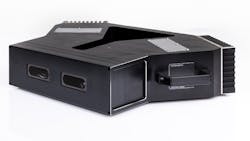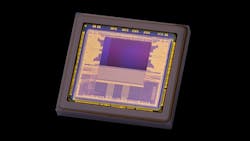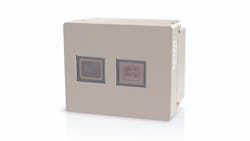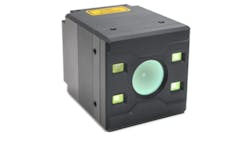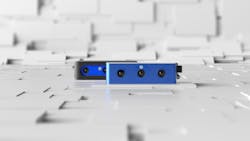3D imaging has been with us for a while now, but in terms of use cases, we are still discovering new places for this vision/imaging method to be used. Continued growth in automation overall means that use will continue to expand on the factory floor. In addition, end user creativity will continue to deploy 3D imaging away from the factory floor as well. So, what’s on the horizon for 3D imaging during 2023?
“3D imaging is a fast-evolving niche, with new technologies being introduced each year,” says Svorad Štolc, CTO of Photoneo (Bratislava, Slovakia; www.photoneo.com) “I believe this year will be no different.” For example, he cites that last year, Photoneo released the MotionCam-3D Color 3D camera. “We are entering the integration phase where our customers adopt MotionCam-3D Color to solve challenges they were not able to solve with any other technology before,” he adds. “The camera unveils new applications and extends the range of industries where 3D vision can be exploited to boost processes.” Štolc explains the greatest value of MotionCam-3D Color lies in the superior quality of 3D data it can provide for artificial intelligence (AI). So, according to Štolc, the combination of high-quality data from MotionCam-3D Color and the analysis of this data by AI is an advancement that opens the door to completely new application areas.
Christian Berendt, Marketing Manager, Chromasens (Konstanz, Baden Wurttemberg, Germany; https://chromasens.de), explains, “Stereo line scan cameras for 3D shape measurement are the newest innovation in line scan technology. For the stereo technique, two image sensors are combined into one camera (much like human vision), resulting in two images being acquired of the same object from slightly different perspectives thus ensuring an unobstructed view of a contoured surface. Light from the same object point is captured simultaneously with both the right and left cameras of the line scanner. As the object moves, it creates stereo images from which the 3D information is calculated by comparing a set of points in an image with the same set of points in the second image. By comparing the two images, the relative depth information can be calculated and produced as a disparity map, in which objects closer to the stereo camera system have a greater disparity than those further away. High-end graphics cards are used to calculate the 3D data from the stereo images at high speed.”
Representatives from Teledyne e2v (Chestnut Ridge, NY, USA; www.teledyne-e2v.com) and Teledyne DALSA (Waterloo, Ontario, Canada; www.teledynedalsa.com) explain what’s on the horizon for 3D imaging from their two divisions.
Ha Lan Do Thu, Marketing Manager 3D applications, Teledyne e2v, says, “We have seen high growth in 3D imaging for industrial applications in the last years, and 2023 will definitely see 3D imaging penetrating the market significantly as the technologies and products are continuously improved.” She states that from the Time-of-Flight (ToF) technology side, the challenge is still on improving the 3D measurement performances while providing high flexibility in operating conditions, which is the strength of ToF technology compared to other 3D techniques. She says there are many technological advances that overcome this challenge at the sensor level. “When you have to cope with a wide range of reflectivity and operating conditions varying from a combination of indoor/short range distance (below 5 m)/high precision to a combination of outdoor/mid-range (10 m, 20 m)/very fast objects moving in the scenes, the high dynamic range feature and a high configurability at sensor level are absolutely necessary. This configurability feature becomes even more powerful if it could be performed frame-to-frame to deal with a real-time changing situation,” she explains. She also notes that pixel technology is crucial to get precise and reliable 3D measurements.
Inder Kohli, Senior Product Manager, Teledyne DALSA, explains that 3D laser line profilers continue to find wider uses in a variety of in-line inspection applications. “Delivering high accuracy at high-scanning rates poses a unique set of challenges,” he says. “Faster scanning speed means less time for the image sensor to gather light. Increasing laser power to overcome this hurdle though seems simple, but it brings the question of eye safety—something that limits its general applicability. Also, the surface properties of the target object—like its color, material composition, and reflectance—affect the choice of lasers. The challenge gets more acute in situations where ambient light is not controllable.” The challenges posed by reflection and occlusion are common in most 3D profiler applications. To address these challenges, 2023 will see an expansion of the capabilities of 3D profilers in two principal ways, according to Kohli, adding features focusing on increased performance and flexibility and the introduction of new 3D laser profilers for faster factory floor deployment.
Software is also critical when processing what a 3D camera sees. Dr.-Ing. André Kasper, CTO, AT – Automation Technology (Bad Oldesloe, Germany; www.automationtechnology.de/cms), says, “After we launched a new 3D sensor series in 2022 with our C6, we have not only expanded but also further developed our software for it. Together with our R&D team, we have succeeded in putting together our new AT SolutionPackage, a fully comprehensive software kit that combines all our previous software features and enables our customers to put their new 3D sensors into operation within 10 minutes. The benefits for our customers include considerably less effort for the installation of the 3D sensors, a much faster time to market as well as a much higher flexibility in terms of functionality and expandability of their applications.”
As one might expect, many end users or integrators seek a single-source solution. Sebastian Sauppe, Product Market Manager at Basler (Ahrensburg, Germany; www.baslerweb.com), explains how Basler is addressing this market request. “At Basler, we see a strong demand for comprehensive 3D vision solutions,” he says. “Customers are increasingly interested in a well-coordinated package consisting of hardware, software, and individual support. This is perfectly in line with Basler's offering of being a full range provider that is also capable of finding or even developing customer-specific products or solutions.
Alexis Teissie, Senior Product Manager for LUCID Vision Labs (Richmond, BC, Canada; https://thinklucid.com/), says “As the 3D imaging market is maturing, the benefits and limitations of various 3D sensing modalities are well understood. Early on, potential users were left experimenting with different 3D imaging techniques to decide which was the best suited for the application. Because of the limited offerings available, some compromise on system parameters such as working distance or field of view (FoV) had to be made. In some way, the system design had to accommodate the limitations of the selected 3D imaging solution. We now see this reversing, with application designers expecting more variety and flexibility out of their 3D imaging technology of choice. LUCID Vision Labs has been answering this trend by diversifying its range of Helios Time-of-Flight cameras.
Finally, Martin Hennemann, Product Management 3D Vision at IDS Imaging Development Systems (Obersulm, Germany; www.ids-imaging.us), says, “One of the things to be excited about is the continued growth in demand for automation in the robotics market. We expect to see even more leading-edge solutions for customers.
Solutions
There are a number of products being introduced that address some of the challenges mentioned above, as well as embody the advancements expected during 2023 for 3D imaging.
Chromasens 3DPIXA 3D line scan cameras offer resolution up to 15,360 pixels in 3D and 2D color with fast stereo algorithms running on GPU, making the family of cameras suitable for imaging tasks where both 2D and 3D are needed. The FOV and resolution of the 3DPIXA cameras is highly scalable, enabling a large variety of applications employing stereo technology. High-resolution 2D color images and 3D measurement accuracy combined with a high acquisition speed uniquely qualifies 3DPIXA cameras for 3D inspection of ball grid arrays, ball and roller bearings, semiconductors, wire bonding, automotive parts, and even road surfaces.
Teledyne e2V’s Hydra3D+ has a unique design combination of features including a brand-new 10-µm three-tap pixel with 10-ns transfer time and high NIR sensitivity delivering temporal noise at high speed and with no motion artifacts. It embeds a multi-system management feature to avoid interferences. With its HDR and on-the-fly flexible configuration, Hydra3D+ is suitable for a wide range of industrial applications such as pick-and-place, logistics, factory automation, and factory safety but also outdoor applications such as automated guided vehicles, surveillance, ITS, and building construction.
AT – Automation Technology’s cxMetrology Package will release at the end of the first quarter of 2023. The package forms part of the AT SolutionPackage with which customers can easily and independently integrate the company’s 3D sensors into their applications and put them into operation promptly. Consisting of the Metrology Explorer as a tool and the Metrology Software Development Kit, the customer receives an initial 3D image of his application within ten minutes and can then evaluate it immediately.
Basler’s blaze ToF camera combines high precision, low power consumption, and low heat generation with proven blaze features. Both its compact IP67 housing and near-infrared operation at 850 nm make it suitable for indoor applications in logistics and factory automation. With its 67° × 51° FOV and a working distance ranging from 0.3 to 10 m, the camera can capture depth data of large objects and entire scenes at once. The 850-nm model's Sony IMX556-DepthSense™ sensor provides precise 2D and 3D data in one shot, consisting of distance, intensity, and confidence maps.
LUCID is expanding again the Helios ToF cameras range with the launch of the Helios2 Wide, enabling wide angle of view in the same compact IP67 platform. Helios2 Wide integrates Sony’s DepthSense™ IMX556PLR back-illuminated ToF image sensor paired with a wide-angle lens providing a 108° angle of view, suited for applications with a close working distance and large area of operation such as full-size palettizing applications. This IP67 Factory Tough™ 3D camera delivers 640 × 480 depth resolution at up to an 8.3-m working distance and a frame rate of 30 fps.
IDS’s Ensenso N 3D cameras have a compact housing (made of aluminum or plastic composite, depending on the model) with an integrated pattern projector. They are suitable for capturing both static and moving objects. The integrated projector projects a high-contrast texture onto the objects in question. A pattern mask with a random dot pattern complements non-existing or only weakly visible surface structures. This allows the cameras to deliver detailed 3D point clouds even in difficult lighting conditions. The cameras use the Sony IMX392 sensor, resulting in 2.3-MPixel resolution. All cameras are pre-calibrated and therefore easy to set up. The Ensenso selector on the IDS Website helps to choose the right model.
About the Author
Chris Mc Loone
Editor in Chief
Former Editor in Chief Chris Mc Loone joined the Vision Systems Design team as editor in chief in 2021. Chris has been in B2B media for over 25 years. During his tenure at VSD, he covered machine vision and imaging from numerous angles, including application stories, technology trends, industry news, market updates, and new products.


